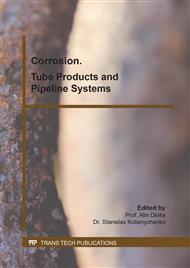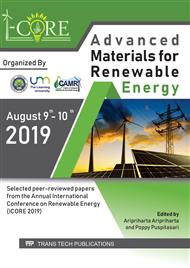[1]
Afandi, Y. K., & Arief, I. S. 2015. Analisa Laju Korosi pada Pelat Baja Karbon dengan Variasi Ketebalan Coating. Journal Of Corrosion Science, 4(1), 1–5.
Google Scholar
[2]
Anggaretno, G., Rochania, I., & Supomo, H. 2012. Analisa Pengaruh Jenis Elektroda terhadap Laju Korosi pada Pengelasan Pipa API 5L Grade X65. Jurnal Teknik Mesin, 1(1), 3–7.
DOI: 10.36289/jtmi.v17i2.378
Google Scholar
[3]
Asadi, V., Danaee, I., & Eskandari, H. 2015. The Effect of Immersion Time and Immersion Temperature on the Corrosion Behavior of Zinc Phosphate Conversion Coatings on Carbon Steel. Journal Of Coating Corrosion, 18(4), 706–713.
DOI: 10.1590/1516-1439.343814
Google Scholar
[4]
Asemani, H. R., Ahmadi, P., Sarabi, A. A., & Mohammadloo, H. E. 2016. Progress in Organic Coatings Effect Of Zirconium Conversion Coating : Adhesion And Anti-Corrosion Properties Of Epoxy Organic Coating containing Zinc Aluminum Polyphosphate ( ZAPP ) Pigment On Carbon Mild Steel. Journal Of Progress in Organic Coatings, 94, 18–27. https://doi.org/10.1016/j.porgcoat.2016.01.015.
DOI: 10.1016/j.porgcoat.2016.01.015
Google Scholar
[5]
Bardal, E. 2003. Corrosion and Protection. London: Springer UK.
Google Scholar
[6]
Chen, X., Zhou, X., Abbott, T. B., Easton, M. A., & Birbilis, N. (2013). Surface & Coatings Technology Double-layered Manganese Phosphate Conversion Coating on Magnesium Alloy AZ91D : Insights into Coating Formation, Growth and Corrosion Resistance. Journal Of Surface & Coatings Technology, 217, 147–155. https://doi.org/10.1016/j.surfcoat.2012.12.005.
DOI: 10.1016/j.surfcoat.2012.12.005
Google Scholar
[7]
Chen, Z., Zhang, G., & Yang, E. 2018. Electrochimica Acta Study of Steel Corrosion in Strain-hardening Cementitious Composites ( SHCC ) Via Electrochemical Techniques. Journal Of Electrochimica Acta, 261, 402–411. https://doi.org/10.1016/j.electacta.2017.12.170.
DOI: 10.1016/j.electacta.2017.12.170
Google Scholar
[8]
Gunawan, E. 2017. Pengaruh Temperatur Pada Proses Perlakuan Panas Baja Tahan Karat Martensitik AISI 431. Jurnal Teknik Mesin, 1, 55–66.
DOI: 10.51804/tesj.v1i1.69.55-66
Google Scholar
[9]
Hagans, P. L., & Haas, C. M. 1994. Chromate Conversion Coatings. Journal Of Chemical Engineering Science, 5, 38–76. https://doi.org/10.1361/asmhba000.
Google Scholar
[10]
Jagtap, R. N., Patil, P. P., & Hassan, S. Z. 2008. Effect Of Zinc Oxide In Combating Corrosion In Zinc-Rich Primer. Journal Of Coating Corrosion, 2. https://doi.org/10.1016/j.porgcoat.2008.06.012.
DOI: 10.1016/j.porgcoat.2008.06.012
Google Scholar
[11]
Jegannathan, S., Arumugam, T. K., Narayanan, T. S. N. S., & Ravichandran, K. 2009. Formation And Characteristics Of Zinc Phosphate Coatings Obtained by Electrochemical Treatment: Cathodic vs. Anodic. Journal Of Progress in Organic Coatings, 65(2), 229–236. https://doi.org/10.1016/j.porgcoat.2008.11.009.
DOI: 10.1016/j.porgcoat.2008.11.009
Google Scholar
[12]
Jones, F. N. 2017. Organic Coatings Science and Technology. United States of America: John Wiley & Sons, Inc.
Google Scholar
[13]
Julisman. 2015. Analisa Sifat Mekanik Permukaan Baja St 37 dengan Proses Pack Carburizing Menggunakan Arang Kelapa Sawit Sebagai Media Karbon Padat. Jurnal Material, 6, 15–29.
DOI: 10.36040/flywheel.v12i2.4280
Google Scholar
[14]
Kusuma, A. 2005. Pengaruh Lapisan Baja Berdasarkan Sifat Elektrokimia Bahan Pelapis. Journal Of Chemical Engineering Science, 2, 23–31.
Google Scholar
[15]
Mahidashti, Z., Shahrabi, T., & Ramezanzadeh, B. 2016. Applied Surface Science A New Strategy For Improvement Of The Corrosion Resistance Of A Green Cerium Conversion Coating Through Thermal Treatment Procedure Before And After Application Of Epoxy Coating. Journal Of Applied Surface Science, 390, 623–632. https://doi.org/10.1016/j.apsusc.2016.08.160.
DOI: 10.1016/j.apsusc.2016.08.160
Google Scholar
[16]
Miskovic, D. M., Pohl, K., Birbilis, N., Laws, K. J., & Ferry, M. 2017. Formation of a Phosphate Conversion Coating On Bioresorbable Mg-Based Metallic Glasses And Its Effect On Corrosion Performance. Journal Of Corrosion Science, 129, 214–225. https://doi.org/10.1016/j.corsci.2017.10.014.
DOI: 10.1016/j.corsci.2017.10.014
Google Scholar
[17]
Morkoc, H., & Ozgur, U. 2009. General Properties of ZnO. Journal Of Chemical Properties, 3, 127–145.
Google Scholar
[18]
Narayanan, T. S. N. S. 2005. Surface Pretreatment by Phosphate Conversion Coatings – A Review . 9, 130–177.
Google Scholar
[19]
Nogara, J., & Zarrouk, S. J. 2017. Corrosion in Geothermal Environment Part 2 : Metals and alloys. Journal Of Renewable and Sustainable Energy Reviews, 1–17. https://doi.org/10.1016/j.rser.2017.06.091.
DOI: 10.1016/j.rser.2017.06.091
Google Scholar
[20]
Parhizkar, N., Shahrabi, T., & Ramezanzadeh, B. 2017. A New Approach for Enhancement of the Corrosion Protection Properties and Interfacial Adhesion Bonds between the Epoxy Coating and Steel Substrate through Surface Treatment by Covalently Modified Amino-Functionalized Graphene Oxide Film. Journal Of Organic Coating, 75, 11–14. https://doi.org/10.1016/j.corsci.2017.04.011.
DOI: 10.1016/j.corsci.2017.04.011
Google Scholar
[21]
Phuong, N. Van, & Moon, S. 2014. Comparative Corrosion Study Of Zinc Phosphate And Magnesium Phosphate Conversion Coatings On AZ31 Mg Alloy. Journal Of Materials Letters, 122, 341–344. https://doi.org/10.1016/j.matlet.2014.02.065.
DOI: 10.1016/j.matlet.2014.02.065
Google Scholar
[22]
Pokorny, P., Tej, P., & Szelag, P. 2016. Chromate Conversion. Journal Of Coating Conversion, 55(2), 253–256.
Google Scholar
[23]
Pratama, T. L., & R, T. N. 2015. Pengaruh Variasi Goresan Lapis Lindung dan Variasi pH Tanah terhadap Arus Proteksi Sistem Impressed Current Cathodic Protection (ICCP) pada Pipa API 5L Grade B. Journal Of Coating Corrosion, 4(1), 3–7.
DOI: 10.20885/teknoin.vol21.iss1.art8
Google Scholar



